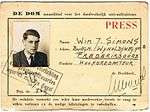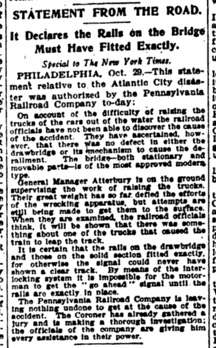Press release
| Journalism |
|---|
 |
| Areas |
| Genres |
| Social impact |
| News media |
| Roles |
|
A press release, news release, media release, press statement or video release is a written or recorded communication directed at members of the news media for the purpose of announcing something ostensibly newsworthy. Typically, they are mailed, faxed, or e-mailed to assignment editors and journalists at newspapers, magazines, radio stations, online media, television stations or television networks.
Origins

The first modern press releases[1] were created by Ivy Lee.[2] Lee's agency was working with the Pennsylvania Railroad at the time of the 1906 Atlantic City train wreck. Ivy Lee and the company collaborated to issue the first press release directly to journalists, before other versions of the story, or suppositions, could be spread among them and reported. He used a press release, in addition to inviting journalists and photographers to the scene as a means of fostering open communication with the media.[3]
Public relations pioneer Edward Bernays later refined the creation and use of press releases.
Elements
Technically, anything deliberately sent to a reporter or media source is considered a press release: it is information released by the act of being sent to the media. However, public relations professionals often follow a standard format that they believe is efficient and increases their odds of getting the publicity they desire. The format is supposed to help journalists separate press releases from other PR communication methods, such as pitch letters or media advisories. Generally, a PR body consists of 4 to 5 paragraphs with word limit ranging from 400 to 500. [4] However, press releases can be anywhere from 300 to 800 words[5]
As the internet has gained prevalence the way journalists like to be approached has also changed. A format suggested by Kristen Nicole, a former Mashable writer who is now the Senior Managing Editor of SiliconANGLE.com. is sending one sentence as to why this story works for my publication, and 5 bullet points for context. Kristen also recommends pitching writers directly over pitching editors saying:
"I’d recommend pitching the writer first, with an angle specific to their beat. If a case needs to be made to the editor, it can fare better coming from the writer, who’s already had an opportunity to work out an angle with the PR rep. As an editor, I’m more likely to prioritize emails coming from those I have personal relationships with. These have been built over the years from the days when I was the writer presenting to my editors. Starting a new relationship with me as an editor, the most successful pitches have been those offering high profile interviews (editors that still write columns will want to take these for themselves before passing them off to junior writers) or highly specific content, like an original guest contribution." [6]
Some of these common structural elements include:
- Headline – used to grab the attention of journalists and briefly summarize the news.
- Dateline – contains the release date and usually the originating city of the press release. If the date listed is after the date that the information was actually sent to the media, then the sender is requesting a news embargo, which journalists are under no obligation to honor.
- Introduction – first paragraph in a press release, that generally gives basic answers to the questions of who, what, when, where and why.
- Body – further explanation, statistics, background, or other details relevant to the news.
- Boilerplate – generally a short "about" section, providing independent background on the issuing company, organization, or individual.
- Close – in North America, traditionally the symbol "-30-" appears after the boilerplate or body and before the media contact information, indicating to media that the release has ended. A more modern equivalent has been the "###" symbol. In other countries, other means of indicating the end of the release may be used, such as the text "ends".
- Media contact information – name, phone number, email address, mailing address, or other contact information for the PR or other media relations contact person.
As the Internet has assumed growing prominence in the news cycle, press release writing styles have necessarily evolved.[7] Editors of online newsletters, for instance, often lack the staff to convert traditional press release prose into more readable, print-ready copy. Today's press releases are therefore often written as finished articles which deliver more than just bare facts. A stylish, journalistic format along with perhaps a provocative story line and quotes from principals can help ensure wider distribution among Internet-only publications looking for suitable material.[8]
Distribution models
In the traditional distribution model, the business, political campaign, or other entity releasing information to the media hires a publicity agency to write and distribute written information to the newswires.[9] The newswire then disseminates the information as it is received or as investigated by a journalist.
An alternative is the self-published press release. In this approach, press releases are either sent directly to local newspapers or to free and paid distribution services.[10] The distribution service then provides the content, as-is, to their media outlets for publication which is usually online.
Video news releases
Some public relations firms send out video news releases (VNRs) which are pre-taped video programs that can be aired intact by TV stations. Often, the VNRs are aired without the stations' identifying or attributing them as such.
TV news viewers can often detect the use of VNRs within television newscasts; for example, many movie-star "interviews" are actually VNRs, taped on a set which is located at the movie studio and decorated with the movie's logo. Another frequent example of VNRs masquerading as news footage is videotapes of particular medical "breakthroughs," that are really produced and distributed by pharmaceutical companies for the purpose of selling new medicines.
Video news releases can be in the form of full blown productions costing tens of thousands or even hundreds of thousands. They can also be in the TV news format, or even produced for the web.
Recently, many broadcast news outlets have discouraged the use of VNRs. Many stations, citing an already poor public perception, want to increase their credibility. Public relations companies are having a tougher time getting their pre-edited video aired.
VNRs can be turned into podcasts then posted onto newswires. Further to this, a story can be kept running longer by engaging "community websites", which are monitored and commented on by many journalists and features writers.
Embargoing
Sometimes a press release is distributed early and embargoed – that is, news organizations are requested not to report the story until a specified time. For instance, news organizations usually receive a copy of presidential speeches several hours in advance. Product or media reviewers are commonly given a sample or preview of a product ahead of its release date.
Unless the journalist has voluntarily agreed to honor the embargo in advance, usually via a legally binding non-disclosure agreement, the journalist is under no obligation to it. However, even in the absence of any obligation, news organizations generally do not break the embargo for sources that they wish to cultivate. If they do, then the agency or client that sent the release may blacklist them.
See also
References
- ↑ The Origin of the Press Release and Its Importance to Press Release Marketing: It’s said that the New York Times was so impressed with Lee’s statement that they ran the story as is, without any revisions or changes to format. 27 January 2012.
- ↑ Mary Bellis. "Invention of the First Press Release". about.com. Retrieved 23 November 2010.
- ↑ Garbo, Joe (29 October 2006). "The 100th Birthday of the Press Release". Search Engine Watch. Retrieved 18 December 2011.
- ↑ James, Geoffrey. "How To Write a Press Release, with Examples". cbsnews.com. CBS News. Retrieved 19 May 2016.
- ↑ "Editorial Guidelines for News Releases | PRWeb". PRWeb. Retrieved 2016-09-05.
- ↑ Pelt, Mason. "How to Get Press for Your Startup". Tech.co. Tech.co. Retrieved 19 May 2016.
- ↑ Goodden, Ron (1 September 2009). "For Businesses Chasing Recognition, The Print Media Is Losing Its Allure". PRWeb.
- ↑ Riggins, Nash. "How to Write a Press Release". www.ducttapemarketing.com. Retrieved 19 May 2016.
- ↑ Human, Tim (11 June 2010). "Wire industry feels the heat as self-publishing tools launch". IR Magazine.
- ↑ McQuivey, James (10 December 2014). "Social, Content Marketing Strategies, Trends for 2015: EmailWire Press Release Distribution Services Presents Guides, eBooks". CIO Magazine. Retrieved 22 December 2014.
| Look up press release in Wiktionary, the free dictionary. |
External links
- Press release -media source
| Wikimedia Commons has media related to Press releases. |